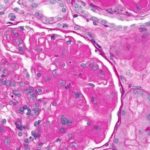1. Litifilimab significantly decreased cutaneous lupus erythematosus (CLE) disease area and severity index scale (CLASI-A) after 16 weeks of treatment.
2. Litifilimab may increase the risk of adverse reactions including upper respiratory tract infection, influenza, herpes zoster, viral rash, and systemic viral infections.
Evidence Rating Level: 1 (Excellent)
Study Rundown: CLE is an autoimmune disease that can result in permanent damage, disfigurement, and decreased quality of life. It is further associated with mental health implications such as depression, anxiety, and fatigue. Litifilimab is currently being investigated as a possible therapeutic agent. It is an IgG1 monoclonal antibody that engages blood dendritic cell antigen 2. This inhibits type I interferons, inflammatory cytokines, and chemokines, targeting the pathophysiology of CLE. The present study compared litifilimab to a placebo control in a group of patients with CLE. The study group showed a significant dose-response relationship in the reduction of their CLE disease area and CLASI-A score after 16 weeks of treatment. A limitation of this study includes concomitant treatment of CLE with other medications, which could affect the effect size of the treatment group.
Click to read the study in NEJM
Relevant Reading: Trial of Anifrolumab in active systemic lupus erythematosus
In-Depth [randomized control trial]: This phase two randomized control trial evaluated the efficacy of litifilimab in reducing CLASI-A after 16 weeks of treatment. Adults 18 to 75 years of age were eligible if they had a histologically confirmed diagnosis of CLE or received biopsy screening for the study. Participants had to have a CLASI-A score of eight or greater at the beginning of the study. The least-squares mean percent changes in CLASI-A scores from baseline to the end of the trial (week 16) were -14.5+/-6.4 for the placebo group, -38.8+/-7.5 for 50mg litifilimab group, -47.9+/-7.5 for 150mg litifilimab group, and -42.5+/-5.5 for 250mg litifilimab group. Negative values represent a clinical improvement from baseline. In comparison to placebo, the CLASI-A score change from baseline to week 16 was -24.3% for 50 mg litifilimab group (95% confidence interval [CI], -43.7 to -4.9), -33.4% for 150mg litifilimab group (95% CI, -52.7 to -14.1), and -28% for 450mg litifilimab group (95% CI, -44.6 to -11.4). The secondary end-point was CLASI-50, a decrease of 50% from the baseline CLASI-A score. The least mean squared difference between treatment group and placebo were as follows: 15.8% for 50mg group (95% CI, -7.2 to 38.8), 21.2% for 150mg group (95% CI, -2.8 to 45.2), and 23.3 for 450mg group (95%CI, 2.9 to 43.6). Litifilimab is a potential treatment for CLE, however larger and longer trials are necessary to determine its true efficacy and safety.
Image: PD
©2022 2 Minute Medicine, Inc. All rights reserved. No works may be reproduced without expressed written consent from 2 Minute Medicine, Inc. Inquire about licensing here. No article should be construed as medical advice and is not intended as such by the authors or by 2 Minute Medicine, Inc.


